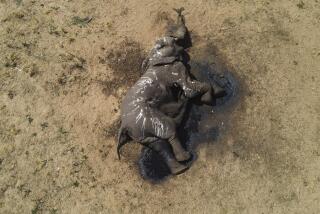Black Rhinos on the Comeback Trail
TSAVO EAST NATIONAL PARK, Kenya — The rifle-toting rangers systematically weave through clumps of thorny bush and scrubby vegetation. Every few paces, they stop, cock their ears for distant murmurs, then check the moist red soil for prints. Finally, the trackers find a huge indentation within freshly upturned earth. They smile. Maria and Ruto, a pair of black rhinos, have been mating here.
“I feel happy, because I expect babies,” says Oliver Mnyambo, assistant warden in charge of the Rhino Unit in Tsavo East, a 4,250-square-mile area of vast rolling plains and scrub-covered hills that is home to a plethora of big game. “Every time trackers see rhinos mating, they are happy.”
The joy comes from knowing that Kenya is one of the few African countries that can lay claim to a stable or increasing black rhino population after a catastrophic decline in the animal’s numbers--from 20,000 in 1970 to fewer than 350 in 1983--primarily due to poaching.
Today, the East African nation has about 450 black rhinos, 51 of which make their home in Tsavo East. An increase in law enforcement to combat rhino rustling, the introduction of private sanctuaries and the relocation of rhinos to more open habitats such as Tsavo East have boosted the animal’s growth rate to as high as 5%.
The trend is giving hope that the demise of the black rhino has been averted.
“The introduction of the rhinos to Tsavo East has been a success story,” Mnyambo says. “In the last year, none has been poached. Only one died as a result of being attacked by lions.”
But conservationists and wildlife managers warn against complacency.
The demand for rhino horn for traditional Chinese medicines and for decorative dagger handles in the Middle East has fueled an illegal international trade. Add to this poverty, the demand for land, civil conflicts, easy access to weapons and a lack of funding for conservation programs, and it isn’t hard to understand why Africa’s black rhino population has plunged.
“The positive trends are only as stable as the political and economic climates of the range states involved,” says Steve Osofsky, a Washington-based wildlife veterinarian and rhino specialist with the World Wildlife Fund. “Successful conservation obviously depends on more than just good wildlife management.”
Money is a major factor. The wildlife group estimates that successful conservation of a rhino habitat costs as much as $2,600 per square mile annually.
Mnyambo’s rhino patrol unit, consisting of up to 10 rangers using only two cars, is responsible for 1,150 square miles of Tsavo East’s vast territory. The team, whose job it is to monitor the animals’ movements, feeding patterns and behavior, knows each rhino by name and print. It begins the day by scouring the earth for tracks. Any human footprints are investigated first.
“If they go a kilometer inside [the bush], then you know that they are up to something,” says Mnyambo, who has been a ranger for more than 20 years.
Bandits will go to great lengths to get rhino horns, which weigh an average of 9 pounds and can eventually fetch up to $450 a pound in Asian markets. Last year, one of Mnyambo’s men was killed in a shootout with poachers. But that hasn’t dampened the rhino unit’s determination to stop the thievery.
“When you’re out with rhinos for a long time, they become part of you, just like your family,” Mnyambo says. “You feel very bad if you see a rhino has been shot dead. Even if one dies naturally, you still feel bad. I have more hope now, and the ones we have, we will try as much as possible to protect them.”
More to Read
Sign up for Essential California
The most important California stories and recommendations in your inbox every morning.
You may occasionally receive promotional content from the Los Angeles Times.











